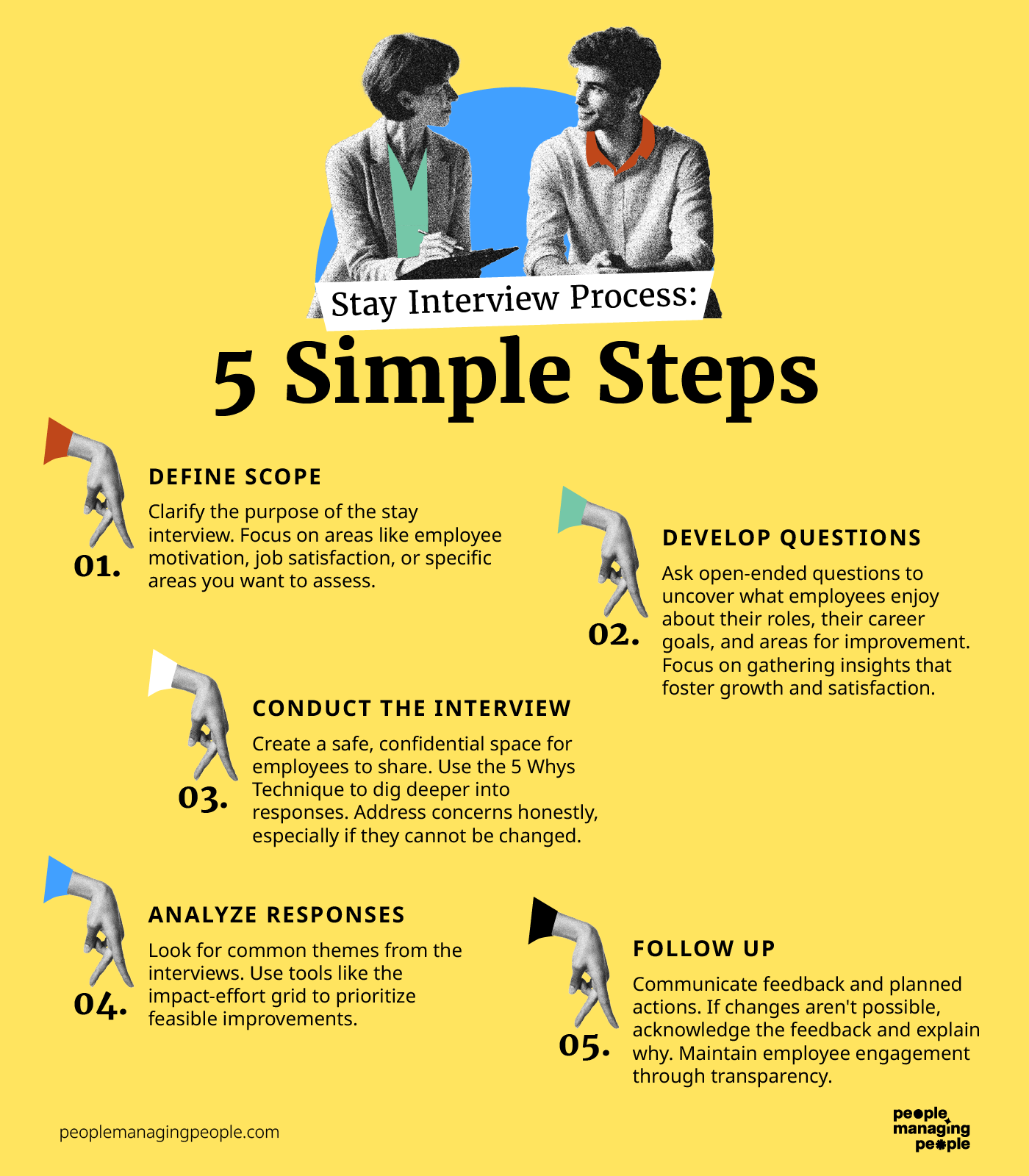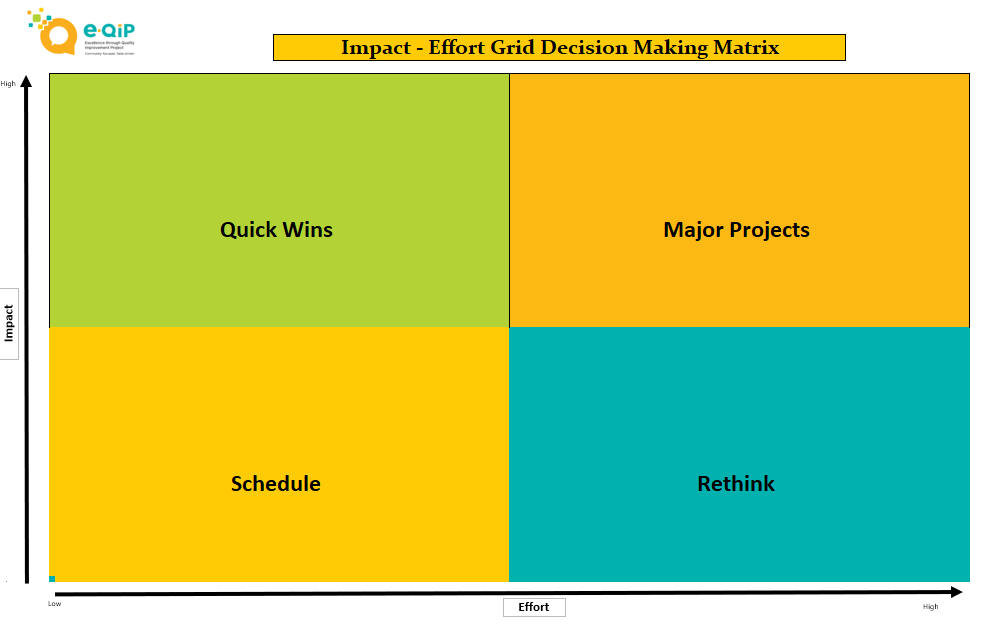Stay interviews are a useful tool to gather valuable feedback to increase employee engagement and retention.
As much as 75% of turnover is for preventable reasons and, more often than not, organizations can easily implement changes that improve the employee experience and prevent employees from handing in a letter of resignation.
This is where the stay interview comes in as a key employee experience tool.
Through stay interviews, my organization has been able to get to the core of some departmental issues as well as address various employee concerns promptly.
In this article, we will define what a stay interview is and the benefits of using them, how they should be conducted, and some questions to help get you started.
What Is A Stay Interview?
A stay interview, sometimes called a retention interview, is a structured conversation between a manager or HR representative and an employee to gauge engagement levels, assess the company culture, learn what’s keeping the employee at the organization, and understand where improvements can be made.
Like exit interviews, stay interviews are part of your employee listening strategy. They’re a great way to gather feedback to improve the employee experience.
Stay interview benefits
- Improve employee retention. By highlighting and addressing issues to improve the employee experience this should help you retain (and attract) top talent.
- Improve employee engagement. Stay interviews can be great drivers of employee engagement since they provide individuals with a voice and make them feel heard. This should in turn lead them to feel like a valued employee and increase their engagement.
- Build trust. An effective stay interview can be a great way to build trust between the one being interviewed and the one conducting the interview. Trust is important in highly functioning organizations, especially remote ones.
- Improve company culture. Data gained from stay interviews can be used to create the workplace culture you want.
As an example, my organization recently conducted a round of stay interviews and many employees brought up the topic of work-life balance.
We used that as an opportunity to dig a little deeper to determine how individuals felt about theirs.
We found that while a majority of people are on a hybrid schedule, it’s not the same across departments and this disparity was causing some friction. We had leaders address this perceived inequality with their teams directly to explain the business reasons for the differences.
This transparency was appreciated as it had been a while since the company had discussed the reasoning for our differing hybrid schedules.
How To Conduct A Stay Interview
Use this process as a step-by-step template for conducting stay interviews in your org.

Step one: Define scope
This part is about clearly defining what you want to gain from the stay interview and if there are specific people, departments, or teams you want to focus on.
Clearly define what you hope to achieve with the stay interview, such as understanding employee motivation, identifying potential issues, or gauging job satisfaction.
Step two: Develop questions
You’ll want to ask open-ended questions that encourage detailed responses, rather than simple 'yes' or 'no' answers. This approach fosters a deeper conversation and provides more insights.
I’ve put together a list of questions in the next section, but here are some principles to help guide you:
- Focus on the positive too: Frame questions to understand what keeps the employee at the company, such as what they enjoy about their job or what they find fulfilling.
- Explore development opportunities: Ask about their career goals and how the company can support their professional development.
- Seek feedback: Include questions about potential improvements in the workplace or management style.
Step three: Conducting the interview
Conducting a stay interview is your team member’s opportunity to share their experience but, understandably, they might be a little hesitant.
To promote honesty, make sure to reiterate the purpose and that their will answers will be treated confidentially.
You’ll have prepared your questions but, rather than simply running through them, listen actively and delve deeper if you think something is worth exploring.
To help elicit richer responses, I recommend making use of the 5 Whys Technique. This handy technique involves asking "why" based follow-up questions to their answer up to five times to dig further into their answer and get more detail.
Another Tip: Someone may bring up a concern that cannot be changed. You will want to address that as soon as possible. Don’t insinuate that you can take action on that concern if it is not possible.
During the round of stay interviews at our corporate office, several employees stated they would like to have the option to be 100% remote. In their specific role within the organization, remote work just isn’t a possibility. Leadership addressed this with them right away.
As a next step, take a look around if anyone else within the organization makes use of the stay interview and ask them about their process for it.
Step four: Analyze responses
Post-interviews, it’s time to analyze the responses—potentially combined with other sources such as employee surveys and HR metrics—to look for common themes and assess what can be achieved.
From here, you can evaluate actionable insights and determine which feedback can be realistically acted upon to improve the work environment.
The impact-effort grid is a handy tool to help you prioritize what’s possible within a given timeframe and start planning out some projects.

For example, we discovered that many of those we spoke to would prefer greater flexibility in the morning and evenings for tasks like childcare, so we introduced a core hours concept with minimal lift.
Early indicators show that this has had a positive impact on employee well-being and will hopefully help us keep our top performers.
Step five: Follow-Up
Fewer things will disenchant your team members more than ignoring their feedback.
This is why it’s important to communicate actions and let employees know that their feedback has been heard and what steps will be taken.
If something is unrealistic then still acknowledge the feedback and explain why. Perhaps there’s a compromise.
Remember, the key to a successful stay interview is genuine engagement with the employees and a commitment to act on the insights gained.
20 Stay interview questions
As promised, a selection of stay interview question examples to help you craft your interview.
The employee
- What would you like to see more or less from me as your manager?
- When was the last time you thought about leaving the company?
- Do you feel that your accomplishments are recognized?
- Do you feel valued as an employee?
- What challenges or barriers to your productivity have you come across lately?
- (If conducted by HR) how do you feel working under X?
The role
- What would you like to see changed in your current role?
- What would make your role more satisfying?
- What skills do you think we are underutilizing in your work?
- What are some skills that you would like to work on in your current position?
- What would an ideal day in your current role look like?
- What would your dream job look like here?
- Do you feel that your goals and objectives are clear and achievable?
The culture
- Do you feel that there’s effective collaboration within the organization?
- Do you feel that people are happy to work here?
- Would you recommend us as a place to work to a friend or family member?
- Do you feel that you’re well-informed about what’s happening in the organization?
- What would you need from us to support you better?
- What is something you had or did in a previous role that you would like to see here?
- What keeps you working here? (Save for the end).
Expert Tip: I would leave questions such as “What keeps you working here?” near the end of your interview—those are the kinds of questions that you build up to.
As a stay interview should typically be an hour at most, this list here should be enough to get you started. And, again, this is a bank of questions to choose from, not a checklist.
One option to consider when conducting stay interviews is whether to send some or all of your questions ahead of time.
A benefit of this is that it allows your employees to come to the interview prepared with well-thought-out responses.
However, by sending questions in advance, you may get a more edited response than if the interviewee answered in the moment.
During the round of stay interviews for the struggling department at my company, we asked the same question to each employee: what would you need from us to support you better?
And we followed up with relevant “why” questions to dig as deep as possible to get to the core of the issues in that department.
Stay Interview Best Practices
- Ask open-ended questions to solicit richer responses.
- Delve deeper using the 5 Whys Technique.
- Act on the feedback and, if you can’t, explain why.
- Conduct stay interviews regularly to track changes in employee sentiment over time.
- Ensure that those conducting the interviews are trained in effective communication and empathetic listening to foster a more productive dialogue.
Stay Interview FAQs
When Should You Conduct Stay Interviews?
Another way of wording this would be "How often should you be conducting stay interviews?" The answer depends on several factors that I’ll talk about below.
Stay interview with new hires
Organizations can make use of the stay interview during the onboarding process for new hires once they’ve settled in and got a feeling for their new job.
I suggest conducting a stay interview around day 90 of someone starting (if you haven't done so, I would suggest your organization look into creating a 30-60-90 day plan to help with employee development).
With new hires, topics to discuss could be what went well in the onboarding process and whether were there any roadblocks.
You can also talk about development opportunities that they would like to explore or their thoughts about the work environment from a new hire’s perspective.
Stay interviews with longer-serving employees
This is up to your discretion—some experts suggest conducting stay interviews 3-4 times a year. However, my personal preference is annually and as needed.
Issues can build up that will chip away at employee satisfaction, so if human resources or managers sense that employees are unhappy or disengaged it is time for stay interviews.
To note, these stay interviews shouldn't take more than an hour, and can even be part of a performance review cycle.
It’s also recommended that managers hold regular check-ins with their direct reports.
Where Should Stay Interviews Be Conducted?
The stay interview does not need to be a super formal meeting—you don't need to be sitting in a boardroom.
You will want a private space where employees can speak freely without anyone overhearing the conversation.
Whether that is a private Zoom call or a face-to-face meeting in a coffee shop will depend on your company’s culture.
My organization has a strong preference for conducting stay interviews in person or on video. I find that folks are more forthcoming than if we are in an audio-only setting. This also allows the interviewer to read non-verbal cues.
Who should conduct stay interviews?
The individual conducting the stay interview can be the direct manager of the current employee in question. But it doesn’t have to be!
In my organization, human resources will conduct stay interviews occasionally.
Remember, more often than not, current employees do not leave jobs—they leave managers. Employees will not be forthcoming in a stay interview if they don’t trust their manager.
At my company, we were seeing an increase in turnover from a particular high-performing department, and leadership wanted to hear from the folks who stayed, in addition to the exit interviews we already conducted.
Instead of having managers conduct the interviews, HR interviewed them, hoping they would be more forthcoming regarding the departmental issues. This pivot turned out to be incredibly fortuitous, as employees were very open about the issues facing their team.
We were then able to share our findings with department leadership and take action on the findings.
What’s the difference between a stay interview and an exit interview?
| Stay interview | Exit interview |
|---|---|
| Conducted during someone’s tenure | Conducted after a resignation has been handed in |
| Preventative | Reactionary |
| Can be conducted by employee’s manager or HR | Conducted by HR or non-direct manager |
What are the goals of a stay interview?
The goal of stay interviews is to gather employee feedback to develop new initiatives and improve the employee experience both for the individual employee and the wider employee population.
This could mean providing more flexible working arrangements, improving employee benefits, or better facilitating internal mobility.
Join The Conversation
Stay interviews are great tools to have in the people management arsenal.
It demonstrates that you value employee’s happiness as well as their opinions, and might be the difference between them staying, getting promoted, and leaving. If you want some more advice on how to conduct them or indeed wish to impart some, leave a question or response in the comments.
You can also apply to join the People Managing People Community, a supportive place where you can connect and share knowledge with experienced industry professionals.




